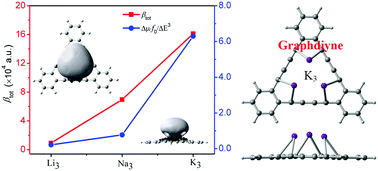Design of novel graphdiyne-based materials with large second-order nonlinear optical properties†
Abstract
In this study, we designed a series of new alkali metal-adsorbed graphdiyne (GDY) structures (denoted as AM3@GDY (AM = Li, Na, K)) with an intramolecular electron donor–acceptor framework using density functional theory calculations. It is found that the three alkali metals are energetically preferred to be adsorbed on the three hollows of the largely delocalized π-conjugated GDY surface, while the adsorption of alkali metals largely affects the electronic properties of the complexes, and reduces the vertical ionization potentials. More interestingly, the doping of alkali metal atoms dramatically enhances the static first hyperpolarizabilities (βtot) of AM3@GDY, of which the K3@GDY cluster possesses a remarkably giant βtot value of ∼1.61 × 105 a.u., which is enough for it to exhibit strong nonlinear optical (NLO) behavior. These findings may provide new insights into the design of novel graphdiyne-based NLO materials and promote further potential applications in optoelectronic nanodevices.

- This article is part of the themed collection: International Year of the Periodic Table : Low Dimensional Carbon Systems


 Please wait while we load your content...
Please wait while we load your content...